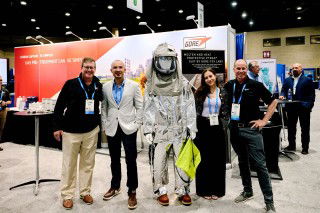Cemtech Europe’s annual conference and exhibition took place at the InterContinental Vienna, Austria, on 20-23 September 2015. Delegates from over 35 countries gathered for the three-day meeting to listen to some of the industry’s leading analysts and technical experts, visit LafargeHolcim’s Mannersdorf cement plant and enjoy the chance to explore Vienna, one of Europe’s great cultural cities.
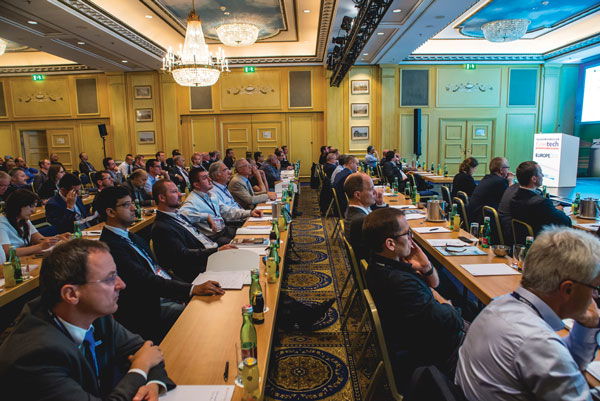
Delegates from over 35 countries gathered for the three-day Cemtech Europe 2015
conference and exhibition in Vienna, Austria
Welcoming delegates to Vienna on behalf of the Austrian cement industry, Sebastian Spaun, managing director of the Association of the Austrian Cement Industry (VOZ), provided an overview of the domestic manufacturing base, which consists of 12 plants producing in the region of 4.5Mta. While relatively small in size, the industry punches well above its weight in terms of technical innovation and is also the world leader in alternative fuels (AF) utilisation, with a thermal substitution rate of 75 per cent achieved in 2014.
Changing Europe
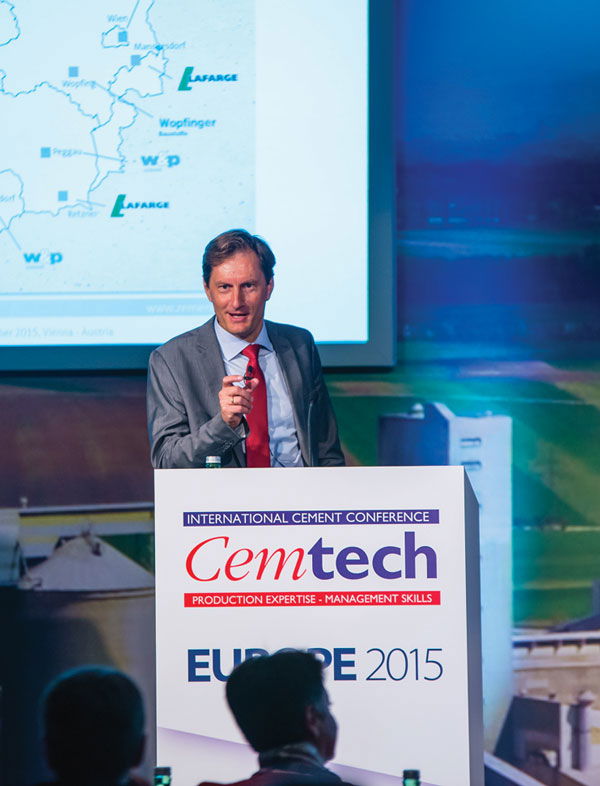
Sebastian Spaun, managing director of the Association of the
Austrian Cement Industry (VOZ), welcomes delegates to Vienna
Thomas Armstrong, managing editor of International Cement Review, considered the dramatic changes in fortunes of the global industry since 2000, the year of Cemtech’s previous meeting in Vienna.
At a worldwide level, cement consumption has expanded by 150 per cent to 4bnt, up from just 1.6bnt in 2000. Of course, it is well known that much of this global growth is down to China, where consumption now stands at 2.5bnt – far more than the entire world consumed in 2000.
Here in Europe, however, the markets have experienced a major boom and bust cycle – first benefitting from the explosive growth of the global economy up to 2007, then suffering under the downturn which followed the global financial crisis.
Thus, cement consumption in western Europe enjoyed unprecedented growth from 2000 to 2008, expanding from 200Mt to 229Mt at its peak, before recession hit the region and demand dived. In 2014 demand was recorded at 124Mt, some 38 per cent lower than in 2000 and 46 per cent below the peak of 2008.
Current trends indicate that most European markets have now troughed and are returning to growth, but the fact remains that the local cement industry has been severely reduced and must adapt to the new reality. New capacity projects are now a rarity as the industry focusses on rationalising production and optimising operations to remain competitive.
M&A – who’s next?
Jean-Christophe Lefèvre-Moulenq, CM-CIC Securities, provided a keynote presentation on European corporate consolidation in the cement sector. He argued that the key strategic error of the major cement groups in the lead-up to 2008 was their willingness to engage in “indiscriminate transforming acquisitions, overpaid and overleveraged, just before the reversal of the cycle.” Between 2008-13 these majors continued to copy each other, “shelving acquisitions and prioritising cost cutting” as their financial condition deteriorated, opening a space for emerging majors to enter the fray.
The last year has seen the process of key shareholders, keen to protect their assets, force the merger of the two largest multinationals – Lafarge and Holcim. This has swiftly been followed by the proposed acquisition of Italcementi by HeidelbergCement – a deal which is supported by the complementary asset portfolios and triggered by the LafargeHolcim merger. To his credit, Jean-Christophe was ahead of this time proposing the merits of this merger at Cemtech in Istanbul in 2014.
The interesting question is now: who will follow? Could Cemex or Votorantim, both of whom are global family groups that have lost charismatic leaders, be the next to seek new partnerships? The creation of ‘VotoCemex’ would create a major competitor with 148Mta of combined capacity.
Can Buzzi Unicem survive the downturn of its home market and remain independent? And will CRH be the predator, and seek the role of a new consolidator? Its acquisition of LafargeHolcim assets could be the beginning of an ongoing process to bring its cement sourcing in-house for the supply of its precast and distribution businesses. This could place some of its independent suppliers, particularly in Germany, in difficulty.
Construction markets
Dasha Lukiniha, economist at IHS (UK), explored the disconnect between the northern and southern construction markets of the European Union, where a recovery is slowly taking hold. Cement consumption is back on a growth trajectory, driven by both residential and non-residential segments, though expansion will be strongest in northern Europe and weakest in the south. The producer cost environment will remain stable, but price gains will stay moderate across the region due to low capacity utilisation levels.
Bartlomiej Sosna, PMR (Poland), surveyed the central and eastern European construction markets, highlighting the particularly-strong forecasted growth in countries such as Romania (8.4 per cent) and Bulgaria (7.9 per cent) over the five-year period to 2020. Growth will be more subdued over this period in Russia (3.6 per cent) and Ukraine (4.2 per cent) on the back of geopolitical instability and low oil prices.
CO2 reduction – new technologies
In the run-up to the COP21 meeting in Paris this December, two timely presentations assessed the imperative for CO2 reduction and the impact on the cement industry of new technologies emerging to address this issue.
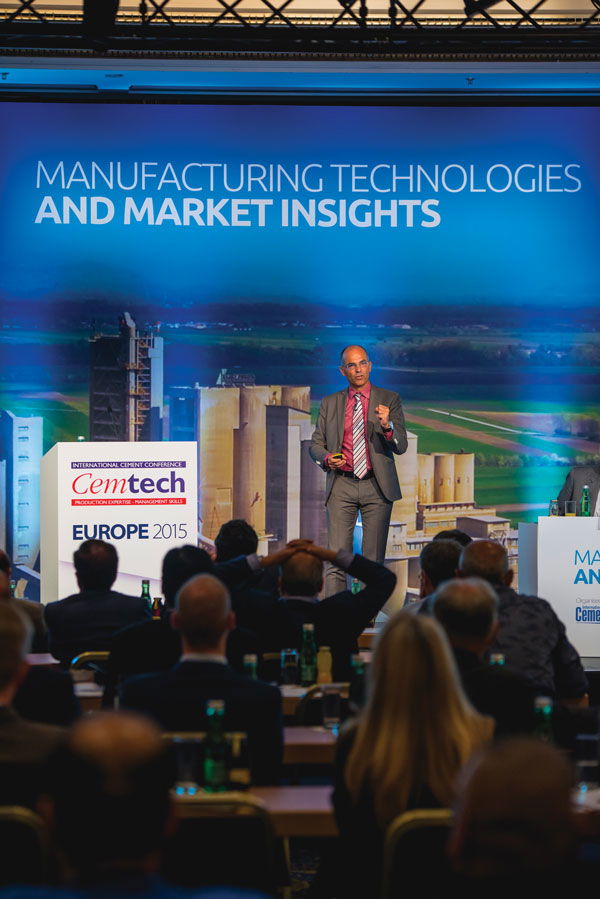
Jan Theulen, global director Alternative Resources,
HeidelbergCement, makes the case for innovative technologies
driving efforts to reduce CO2 emissions in the cement industry
Jan Theulen, global director of Alternative Resources at HeidelbergCement, delivered a keynote presentation exploring the theme of turning waste into a resource, illustrated by some of the cement major’s impressive worldwide experiences. The company’s sewage sludge co-processing in Guangzhou, China, for instance, has reduced coal consumption by 20,000tpa, resulting in 40,000tpa CO2 savings. In Europe the company’s kilns are achieving over 80 per cent substitution. Advanced techniques in AF utilisation employed by the group include oxygen enrichment and the fine milling of fuels such as refuse-derived fuel to increase the AF rate and upgrade clinker quality.
In addition to reviewing current achievements, Jan updated delegates on some of the cutting-edge CO2 reduction initiatives now under investigation by HeidelbergCement. While a range of experimental technologies are in the pipeline, it is carbon capture that represents the best chance for the industry. The company is taking a lead role, together with the European Cement Research Academy (ECRA), to build the first large-scale pilot plant for cement carbon capture at HeidelbergCement’s Norcem plant in Norway. Carbon capture is expected to account for 46 per cent of CO2 reductions from the cement industry by 2050, according to the IEA Technology Roadmap, making this research pivotal to the future of the sector.
Addressing the theme ‘Harnessing CO2’, Michel Gimenez provided an overview of LafargeHolcim’s research activities into CO2 capture and reuse technologies. Of particular note is the company’s work in developing the new SOLIDIA binder, which combines direct CO2 reduction during the production process and CO2 recapture during material setting, with the potential to reduce CO2 by up to 70 per cent (see ICR August 2015).
Manufacturing technologies
This Cemtech programme offered the ideal opportunity to highlight the strong tradition of technology innovation in the Austrian cement industry, a subject that was addressed by Dr Felix Papsch of the Association of the Austrian Cement Industry (VOZ). In addition to achieving the highest levels of AF utilisation in the world, domestic equipment suppliers have collaborated with local cement producers on a variety of R&D projects with great success. These include the world’s first semi-dust catalytic reduction (SCR) system installed by Scheuch at the LafargeHolcim Mannersdorf plant. The SCR system has reduced NOx emissions by 60 per cent to within the 200mg/Nm3 target limit.
In its next initiative, the Austrian cement sector is now seeking to systematically reduce the clinker content of all cements. Average clinker content is currently recorded at 69.8 per cent, down from 78.6 per cent in 1997. Raw materials used include slags, used foundry sand, mill scale and various ashes. The association aims to develop new standards and work with the cement industry to achieve even higher rates of substitution in future.
Michael Suppaner (A TEC, Austria) and Georg Lechner (Scheuch, Austria) presented a case study of the entirely new ‘ex-mercury’ system installed at Wietersdorfer Zement (Austria), capable of reducing mercury emissions by 80 per cent. The system first separates the dust from the mercury-loaded process gases, which are then treated with a sorbent. The resulting bound mercury can subsequently be separated from the gas stream, with the clean gases returned to the raw mill.
Major new plant projects reported on in the conference included Naseer Siddiqui’s account of Saudi White Cement’s upgrade project at the company’s plant near Riyadh, which boosted capacity from 700tpd to 1000tpd in 2013. Pietro De Michieli, Bedeschi, described the recently completed wet-to-dry conversion of the kiln line at Akmenes Cementas in Lithuania.
Marco Goisis, from Italcementi’s technical centre in Bergamo, Italy, gave delegates a true masterclass on the topic of grinding, describing the fundamental laws of comminution before providing an objective evaluating the pros and cons of different grinding technologies, including ball, roller and VRM mills.
Focus on AF
Given Austria’s achievements in AF, it was not surprising that this topic was central to Cemtech Vienna’s agenda. Jaroslav Stoupa, Eurocement (Russia), provided a detailed overview of AF and raw material utilisation in the Russian cement industry. While alternative fuels represent only around one per cent of the fuel mix (inevitably, gas represents an 88 per cent share), the Russian cement industry uses around 17 per cent of alternative raw materials in the production of cement, including conventional blastfurnace slags and ashes but also more unusual materials such as nepheline waste sludge, a byproduct of the alumina process, which is used at Peterburgcement LLC and Pikalevskiy Cement CJSC, both Eurocement subsidiaries.
Neville Roberts, representing N+P Recycling, The Netherlands, presented ‘Subcoal’, a pelletised waste-derived fuel suitable for displacing chipped tyres.
Sebastian Frie, ThyssenKrupp Industrial Solutions, reviewed the Prepol Step Combustor, a static system for burning coarse alternative fuels, which is installed at Holcim’s Lägerdorf plant in Germany. The system can substitute up to 85 per cent in the calciner and has a retention time of 15-20min, making it an alternative solution to FLSmidth’s hot disc system.
Donat Bösch, SID SA, presented a shredding, mixing, pumping (SMP) system for hazardous alternative fuels, whereby the waste is turned into a homogenous, pumpable slurry and dosed into the kiln system.
Other topics covered in this comprehensive programme included financing cement projects (Florence Bachelard-Bakal, EBRD), bulk materials handling (Inform, Beumer, BPI Visqueen), SCR/SNCR technologies (Scheuch), and filtration (FLSmidth, Ecospray Technologies).
AF in practice at Mannersdorf cement plant
No Cemtech event is complete without the plant visit and LafargeHolcim kindly opened the doors of its Mannersdorf cement plant to Cemtech delegates.
Located in Lower Austria, around 30km from Vienna, the plant is equipped with a KHD roller press (250tph) for raw milling and, rather unusually, a Voest-Alpine PASEC precalcining system (2500tpd). Clinker grinding is carried out by two ball mills (FLSmidth and Krupp Polysius) with a combined cement capacity of 1.2Mta.
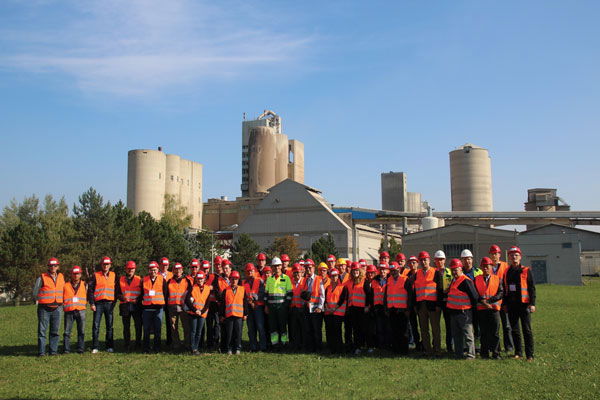
Delegates visited LafargeHolcim’s 1.2Mta Mannersdorf cement plant in Lower Austria
Mannersdorf began burning alternative fuels in 1996 and currently has a total substitution rate of 60 per cent, with RDF (50-55 per cent) the dominant fuel, followed by animal meal, sunflower shells and impregnated solid fuel. Conventional fuels, namely coal and petcoke, make up the balance.
Exhibition as further resource
The Cemtech exhibition once again offered an exceptional resource for cement producers seeking out new equipment suppliers and advice from experts on modernising or optimising their operations.
Goodnight Vienna
Cemtech Europe 2015 culminated in a sumptuous Gala Dinner at the InterContinental’s grand Johan Strauss Ballroom. A wonderful evening of Viennese entertainment ensued, drawing on the rich classical tradition of Austrian classical music and opera – a fitting tribute to the host city and a perfect finale for the official close of Cemtech proceedings.
Article first published in International Cement Review, November 2015.
